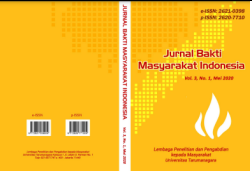PENYULUHAN TEKNIK BERJALAN KAKI YANG BENAR BAGI KELOMPOK LANJUT USIA DI GEREJA KRISTEN INDONESIA NURDIN, JAKARTA
Main Article Content
Abstract
The prevalence of non-communicable diseases (PTM) is increasing rapidly. PTM prevention can be done by modifying risk factors such as increased physical activity (sports). Aside from prevention, physical activity has a therapeutic effect. However, choosing one type of exercise is apparently not simple. Many factors must be considered including the level of fitness, age, field conditions and others. Another factor to consider is exercise time. For people without the risk of heart attack, physical exercise (sports) can be done at any time. But it needs to be considered if the sport is done outdoors, it should be done at a safe temperature and humidity. For the high risk group for heart attack, the best exercise time is around 15.00 - 16.00 which is the highest fibrinolytic activity and the lowest coagulation activity, while the least good time is around 09.00 - 10.00 ie the highest coagulation activity and activity the lowest fibrinolytic. Among the many types of exercise, walking is one type of physical activity that is easy and inexpensive. Walking has good health benefits for the elderly. However, walking must be done with the right techniques in order to provide the expected benefits and prevent negative effects, which is minimizing the risks when walking. This counseling is done so that the participants can understand the correct and safe walking technique and do the walking according to the correct technique
ABSTRAK:
Prevalensi penyakit tidak menular (PTM) meningkat dengan pesat. Pencegahan PTM dapat dilakukan dengan modifikasi faktor risiko antara lain peningkatan aktivitas fisik (olah raga). Disamping sebagai upaya pencegahan, aktivitas fisik memiliki efek terapi. Namun demikian, memilih satu jenis latihan ternyata tidak sederhana. Banyak faktor harus dipertimbangkan antara lain tingkat kebugaran, usia, kondisi lapangan dan lain-lain. Faktor lain yang perlu dipertimbangkan adalah waktu ber olah raga. Bagi orang tanpa risiko serangan jantung, latihan fisik (olahraga) dapat dilakukan kapan saja. Namun perlu dipertimbangkan bila olahraga dilakukan outdoor, sebaiknya dilakukan pada suhu dan kelembaban yang aman. Bagi kelompok risiko tinggi terhadap serangan jantung, waktu latihan yang paling baik adalah sekitar pukul 15.00 – 16.00 yaitu saat aktivitas fibrinolitik paling tinggi dan aktivitas koagulasi paling rendah, sedangkan waktu yang kurang baik adalah sekitar pukul 09.00 – 10.00 yaitu saat aktivitas koagulasi paling tinggi dan aktivitas fibrinolitik paling rendah. Diantara banyak jenis latihan, jalan kaki adalah salah satu jenis aktivitas fisik yang mudah dan murah. Jalan kaki memiliki manfaat kesehatan yang baik bagi lansia. Namun demikian jalan kaki harus dilakukan dengan teknik yang benar agar memberikan manfaat yang diharapkan dan mencegah efek negatif, yaitu meminimalisir risiko saat melakukan jalan kaki. Penyuluhan ini dilakukan agar para peserta dapat memahami teknik jalan kaki yang benar dan aman serta melakukan jalan kaki sesuai teknik yang benar.
Article Details
This work is licensed under a Jurnal Bakti Masyarakat Indonesia https://creativecommons.org/licenses/by-nc-sa/4.0/
References
American College of Sports Medicine. (2006). ACSM’s Guidelines for exercise testing and prescription. 7th ed. Lippincott Williams & Wilkins. Baltimore, Maryland.
de Oliveira, EP. & Burini, RC. (2011). Food-dependent, exercise-induced gastrointestinal distress. Journal of International Society of Sports & Nutrition, 8: 12. doi: 10.1186/1550-2783-8-12.
Garrick, JG. & Requa, RK. (2003). Sports and fitness activities: the negative consequences. Journal of American Academy of Orthopaedic Surgeon, 11(6):439-43.
GBD 2015 Risk Factors Collaborators. (2016). Global, regional, and national comparative risk assessment of 79 behavioural, environmental and occupational, and metabolic risks or clusters of risks, 1990–2015: a systematic analysis for the Global Burden of Disease Study 2015. Lancet, 388(10053):1659-1724
Morton, DP. Richards, D. & Callister, R. (2005). Epidemlology of exercise-related transient abdominal pain at the Sydney City to Surf community run. Journal of Science & Medicine in Sport, 8(2):152–162.
Moses, FM. (1990). The effect of exercise on the gastrointestinal tract. Sports Medicine, 9(3):159-72.
Patelis, N. Karaolanis, G. Kouvelos, GN. Hart, C. Metheiken, S. (2016). The effect of exercise on coagulation and fibrinolysis factors in patients with peripheral arterial disease. Experimental Biology and Medicine, 241. doi:10.1177/1535370216660215.
Pauwels, N. (2012). Towards evidence based emergency medicine: Best BETs from the Manchester Royal Infirmary. BET 1: Is exercise-related transient abdominal pain (stitch) while running preventable? Emergency Medicine Journal, 29(11):930-931.
Physical Activity Task Force. (2012). The co-benefits of physical activity. http://www.beactive.wa.gov.au/index.php?id=483.
Pusat Data dan Informasi. (2015). Pembinaan Kesehatan Olahraga di Indonesia. Kementerian Kesehatan RI. www.depkes.go.id/download.php?file=download/pusdatin/infodatin/olahraga.pdf.
Scott, C. (2005). Misconceptions about Aerobic and Anaerobic Energy Expenditure. Journal of International Society of Sports & Nutrition, 2(2): 32–37.
Sharma, A., Madaan, V., Petty, FD. (2006). Exercise for Mental Health. Prim Care Companion to the Journal of Clinical Psychiatry, 8(2): 106.
Szymanski, LM. & Pate, RR. (1994). Effects of exercise intensity, duration, and time of day on fibrinolytic activity in physically active men. Medicine & Science in Sports & Exercise, 26(9):1102-1108.
Taylor, D. (2014). Physical activity is medicine for older adults. Postgraduate Medical Journal, 90:26-32.
U.S. Department of Health and Human Services. (2018). Physical Activity Guidelines for Americans. 2nd ed.. https://health.gov/paguidelines/second-edition.
WHO. (2009). Interventions on diet and physical activity: what works: summary report. Geneva, World Health Organisation. http://www.who.int/dietphysicalactivity/summary-report-09.pdf.
WHO. (2010). Global recommendations on physical activity for health. http://whqlibdoc.who.int/publications/2010/9789241599979_eng.pdf.



